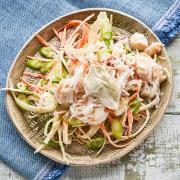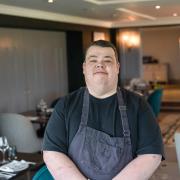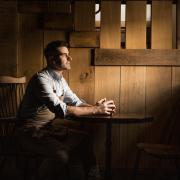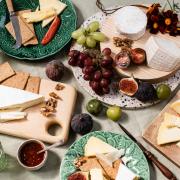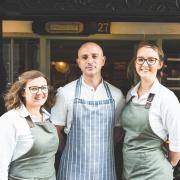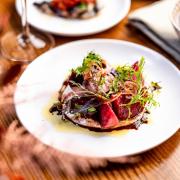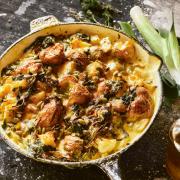Around a year ago I started introducing animal products into my diet again after being plant based for five years. We all have our own journey with food. I never would have thought I would go back to eating animal products, but due to personal issues I decided to make the change.
I have always been very conscious about where I source my food from. Years ago, when I sold my cakes and desserts at farmers markets in Hampshire I had an espresso machine. Being a farmers’ market I had to use 70 per cent of a local ingredient, so for my milk I chose a local jersey cow farm which produced raw milk.
Moving to Devon I discovered Taw River Dairy, near Okehampton and the farm run by Sam and Gemma Bullingham.

They farm organically and regeneratively, the cows are 100 per cent antibiotic-free and aren’t fed any grain at all, so they are 100 per cent pasture-fed.
They operate a ‘calf at foot’ system which means the dairy cows keep and rear their calves, something that is fundamental to Sam and Gemma’s holistic beliefs and which is ‘back to basics’, back to their roots and back to the ways their grandparents kept dairy cows. After all, Sam's grandfather provided milk in a very similar way for the local area more than 60 years ago, so it is in his heritage to do the same.
The small eco-friendly farm is home to around 70 Jerseys, both pure-bred and crossed with other native dairy breeds.

‘We believe that happy cows produce happy milk, and we think that because our cows are grazing as many days as possible and all rear their own calves, then they must be among the happiest cows in the country,’ says Sam.
‘Due to our natural system the cows are only milked once a day, we take just half of the milk to make sure the calves do not go hungry. This delicious raw milk is then taken to our on-site processing room, where it is turned into our products.’
Almost all of the farm’s Jersey cows produce A2 milk proteins (85 per cent of the milk is A2 protein) which studies are now finding to be more easily digestible than standard milk.
‘This means even those who have been called milk or dairy intolerant can enjoy the great taste of grass fed Jersey milk,’ says Sam.

The farm produces beef from belted Galloways which are raised free from antibiotics and chemicals, and live outside 24/7, grazing diverse meadows on the farm. A small flock of Exmoor Horn sheep cohabit with the cows and help maintain the species rich meadows where the cows graze.
Taw River Dairy has always been about caring for our environment; wherever possible they use sustainable options, from re-usable glass bottles to compostable ice cream spoons.

Sam says: ‘All our land and animals are farmed organically and we have our own beehives; our bees are important in the pollination of our herbal and grass leys.’
Taw River Dairy milk and ice cream is supplied to around 50 local stockists within a 30 mile radius of the farm. There’s also an honesty shed at the farm where you can buy its products.
Sarah Raisbeck trained as a chef at Tante Marie in Surrey and is the author of Natural Sweet Bakes.
Emma Stoner is a documentary and lifestyle photographer based in Totnes.

Portuguese custard tarts recipe
For six years I had a stall at farmers markets in Hampshire with my business, Potts Pantry. I specialised in desserts and patisserie and these custard tarts meant my day started at 4am. I have no idea how many tarts I have made over the course of those six years, but as they were, by far, the most favourite tarts for many of my customers, I did not mind the early start.
Using raw milk and cream makes these even tastier!
Even though I am suggesting using ready-made puff pastry in this recipe, by all means, make your own if you have the time. Preparations start the day before you want them.
Makes 25.
Ingredients
1 packet puff pastry
500ml cream
250ml milk
10 egg yolks
1 vanilla pod
80g caster sugar (I use a raw organic cane sugar)
Ground cinnamon, to dust
I use deep, loose bottom, non-stick muffin tins for these tarts.
Custard and pastry cases
Method
Make the custard first as it needs to chill in the fridge overnight.
Cut the vanilla pod lengthways and scrape all the seeds out, put the seeds and pod in the pan. Add the milk and cream. Warm the mixture until it just comes to a simmer. Let it sit for 30 minutes to infuse.
In a bowl add the egg yolks and sugar, whisk until light and creamy. Once the milk mixture is ready, slowly pour this over the yolk mix, whisking slowly all the time until well incorporated. Place the vanilla pod in the bowl, cover the bowl and put in the fridge overnight.
Prepare the pastry cases as they need to rest in the freezer or fridge overnight too.
Roll the pastry to a thickness of 4mm and use a 20cm round cutter to make your circles.
I like to cut a strip of greaseproof paper, no wider than the width of the base and about 1-2cm higher than the depth of the tin so you can use the sides to easily lift the tart from the tin once baked. Line the tins with the pastry circles making sure they are pressed well into the tin. Place your prepared pastry cases in the freezer overnight. The fridge is also fine.
Assembly and baking of the tarts
The next day, preheat the oven to 200C / Gas 6.
Give the custard a good stir and pour into the lined tins straight from the fridge or freezer. Don't overfill the cases with custard, leaving 3mm space from the top.
Place in the oven and bake for 25-30 minutes, turning after 15 minutes. Bake until golden.
As soon as the tarts come out of the oven remove them from the tins onto a cooling rack as otherwise they may stick if any of the custard has spilled over.
Dust with cinnamon and eat as you wish. Fresh is always best! My dad has been known to heat these on top of the woodburner the next day to enjoy with his coffee.

How to make butter or ghee
It is a shame to let leftovers of whipped cream go to waste. So why not turn them into butter, as that is exactly how butter is made. And when you have a glut of butter, you can even go as far as making your own ghee. This is great to get kids involved in too.
Ghee is very popular but also expensive to buy. Making your own is easy and much cheaper. It’s produced by heating butter to remove the milk solids and water. I use it when frying onions or cooking pancakes.
There are many benefits to ghee, such as its high smoke point. Packed with fat soluble vitamins, it is free of lactose and casein. It contains conjugated linoleic acid and it’s loaded with butyrate. It strengthens your bones and promotes healthy weight loss as it improves digestion and reduces inflammation. And best of all, it still has a strong buttery flavour.
To make butter.
Take a pint of organic cream and pour into a bowl. Using an electric or hand whisk, whisk until the cream starts to separate, whisk past the point of soft peaks. Keep going until it becomes very separated. Place a sieve over a bowl and pour the mix into the sieve. The liquid that strains through is buttermilk and can be used in cooking.
If you want to add salt to your butter do so now. Adding a very generous pinch of salt, use your hands to mix it in. Transfer your butter to a pot or tub and use as you wish. Store in the fridge in an airtight container.
To make ghee.
Take your butter, ideally organic, homemade or a packet of unsalted butter.
Place into a pan over an average heat and watch it melt slowly. Let it simmer slowly, stirring occasionally, it may spit. Simmer for 20 minutes until the milk proteins have separated from the golden liquid. Be careful it doesn’t burn.
Leave to cool to room temperature.
Skim the liquid - which is the milk proteins - off the top of the ghee. Or alternatively, strain the liquid through a sieve lined with cheesecloth, nut bag or muslin into a jar.
This beautiful golden liquid can now be used in place of cooking fats and oils.
If kept in a sealed container, Ghee can last for weeks at room temperature and months if stored in the fridge.














